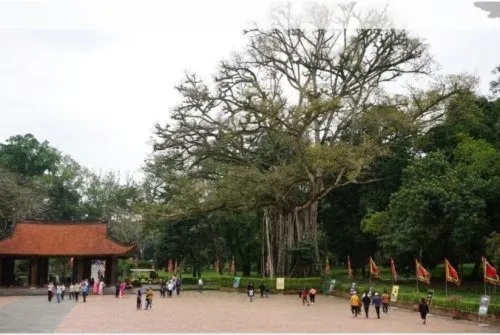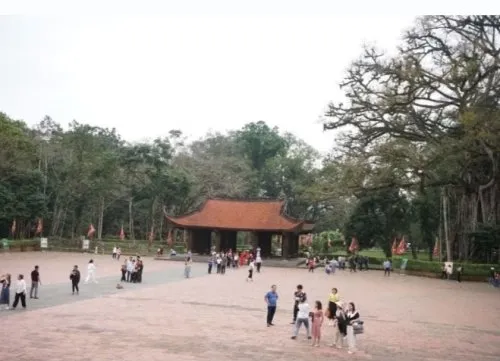Thọ Xuân, Thanh Hóa is becoming a popular destination for tourists, thanks to its harmonious blend of natural beauty and long-standing cultural and historical values. In the first quarter of 2024, it welcomed over 215,000 visitors, testament to its growing allure. One of the standout attractions drawing visitors from near and far is the Lam Kinh Historical Site.
Lam Kinh, the resting place of kings and royals of the Lê dynasty, is not only an important historical site but also a symbol of Vietnamese culture and tradition. If you’re planning to explore this area, join “Travel Around the World” to learn how to visit the Lam Kinh Historical Site fully and meaningfully.
Discovering the Lam Kinh Historical Site: A Journey to the Roots
The Lam Kinh Historical Site, also known as Tây Kinh, is a complex of tombs and temples dedicated to the kings and queens of the Lê dynasty, located in Thọ Xuân District, Thanh Hóa Province. This site not only holds immense historical and cultural value but also boasts majestic natural landscapes, offering unforgettable experiences for visitors.
History of Formation and Development
Lam Kinh was built in the 15th century, after King Lê Thái Tổ ascended the throne and chose this area for his ancestors’ burial site. Despite numerous historical changes, the site has retained unique architectural features and distinctive cultural value.
Guide to Visiting Lam Kinh
There are several ways to get to the Lam Kinh Historical Site:
- Bus: From Hanoi, you can take a bus to Thanh Hóa at My Dinh or Giap Bat bus stations. From Thanh Hóa city, continue by bus or taxi to Lam Kinh.
- Train: Traveling by train is also a convenient option. You can purchase a ticket to Thanh Hóa station, and then proceed by bus or taxi to Lam Kinh.
- Private Vehicle: If you want flexibility in timing and schedule, a private vehicle is a suitable choice. From Hanoi, follow National Highway 1A or the Hanoi-Ninh Binh-Thanh Hóa expressway to Lam Kinh.
Exploring Remarkable Architectural Structures
The Lam Kinh Historical Site comprises several ancient architectural works, each carrying its own historical significance and value.
- Quang Duc Temple: Dedicated to the Lê dynasty kings, Quang Duc Temple is renowned for its traditional wooden architecture and intricate carvings.
- Dragon Courtyard: The Dragon Courtyard, paved with stone and adorned with majestic dragon and phoenix imagery, was the venue for major royal ceremonies.
- Lê Kings’ Tombs: The tomb complex is the final resting place for the kings and queens of the Lê dynasty. Each tomb features unique architecture, reflecting the power and status of the deceased.
- Ancient Well: The ancient Lam Kinh well has been a source of water for the site since olden times. Today, it still holds water and is used by locals.

To ensure a complete visit, spend at least half a day exploring the architectural structures and learning about the site’s history.
Visitor Tips
To have a smooth and meaningful visit to the Lam Kinh Historical Site, consider these tips:
- Attire: Choose respectful, appropriate clothing for the spiritual ambiance of the site.
- Maintain Cleanliness: Avoid littering and help preserve the site’s scenery and environment.
- Respect the Site: Do not touch artifacts or write on walls or architectural structures.
- Pre-Visit Learning: Read about the site’s history and culture for a more profound understanding.
- Hire a Guide: If possible, hire a guide for detailed information on the site’s history, architecture, and interesting stories related to Lam Kinh.
Enjoy Local Cuisine: The Flavors of Thọ Xuân
Besides exploring historical sites, don’t miss out on local specialties of Thọ Xuân. The local cuisine is rich in countryside flavors, with fresh ingredients and unique preparation methods.
- Luận Văn Grapefruit: Known for its sweet and juicy taste, this grapefruit is grown in Tho Xuong Commune.
- Tứ Trụ Gai Cake: A traditional cake with a delicious, chewy texture, specific to the Tứ Trụ village.
- Thanh Hóa Fermented Pork Rolls: Famous fermented pork rolls with a signature sour and spicy taste, a favorite snack among many.
- Răng Bừa Leaf Cake: A rustic cake with a unique shape, made from rice flour with meat and shrimp filling.

You can find these dishes at local markets, restaurants, or roadside stalls.
Traditional Festivals: The Cultural Vibrance of Thọ Xuân
Thọ Xuân is rich in cultural traditions, offering various festivals throughout the year. If you visit, don’t miss the chance to participate in festivals and experience the distinct local culture.
- Lê Hoàn Temple Festival: Held annually in March (lunar calendar) to commemorate the heroic deeds of King Lê Hoàn.
- Muong Tien Ban Festival: Takes place in Xuan Phu Commune, a harvest prayer festival by the Muong people.
- Ky Phuc Festival: Organized in several villages, this festival wishes for favorable weather and abundant crops.

Participating in these festivals will give you an opportunity to learn about the customs, habits, and cultural values of the Thọ Xuân people.
Conclusion
The Lam Kinh Historical Site is not only an enticing tourist attraction but also a repository of precious cultural and historical values of the nation. With the detailed guide above, we hope you will have a meaningful and memorable visit to Lam Kinh. Don’t forget to explore the unique cultural and culinary beauty of Thọ Xuân for a more fulfilling journey. Enjoy your exciting adventure!